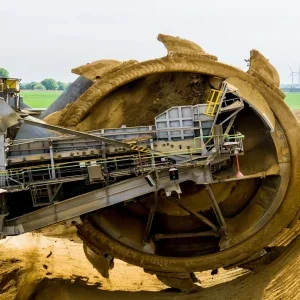Strongly anomalous hand held spectrometer results, 2.4km southwest of the current Zone 2 resource area.
Abundant high grade results continue to be returned from Zone 1 and Zone 2.
The broad zones of strong uranium mineralization from Rossing South continues to increase the known size of this massive mineralised system.
Extract Resources Managing Director, Peter McIntyre, said “The rapid growth of Zones 1 and 2 is now being complimented by the potential of a third zone of mineralisation along the same Rossing South trend. The potential of the entire 15 kilometre trend is enormous, with some degree of mineralisation being encountered on every line drilled to date.”
“The Company intends to add further value to the project through ongoing exploration and resource definition drilling aimed at defining the full potential of the project. The Company is also, pushing ahead with the Rossing South Feasibility Study on Zones 1 and 2 to get the project into production in the shortest possible time frame.”
Zone 3
One RC rig is drilling deeper holes as follow up to shallow exploration drilling on a line 1.2 kilometres south of the Zone 2 resource. Recently received chemical assay results have confirmed strong zones of uranium mineralization beneath the original line of exploration drilling. The company is confident that a second line of drilling, 400 meters to the south, will continue to extend and increase the known dimensions of mineralization.
Another RC rig is completing a line of drilling 1,200 meters south of the Zone 3 line. This drilling is aimed at following up on a zone of strongly anomalous uranium mineralization defined by reconnaissance exploration drilling, a further 400 meters to the south. Both lines of drilling being completed in this area have returned some exceptional results, as indicated by hand held spectrometer surveys of the drill samples, with multiple mineralization zones intersected.
Results returned thus far, include: 30m at 1,240 ppm eU and 21m at 1,466 ppm eU. These high grade intersections were returned from pegmatitic leucogranites (alaskite) with abundant smoky quartz and clumpy biotite.
Typically, the eventual chemical assay grade for a sample is 2 to 3 times the grades seen on the handheld spectrometer. Chemical assays from these holes are expected within the next 4 weeks.
General Exploration
Extensive exploration potential still remains to be tested throughout the Husab Project with priority given to Rossing South. The recently acquired helimag data captured on a 50 metre line spacing reiterates the exploration potential at Rossing South concealed by the Namib Desert. Uranium mineralisation defined at Rossing South thus far has been intersected mainly in the east limb of the Rossing South antiform. Significant potential still remains to be tested in the west limb position, along strike to the south and in the true Rossing position located about 2 km further west.
The smaller capacity exploration RC rig is currently off site, but will return in about four weeks to resume reconnaissance exploration and sterilisation drilling for mine infrastructure.
Salem Exploration Update
One RC rig is drilling at the Salem prospect, about 10km south of Rossing South Zone 2. The holes are targeting a radiometric anomaly associated with a series of alaskite dykes that have intruded a grey granite. Initial handheld spectrometer results on drill samples, from all the holes completed so far at Salem, are very encouraging – with numerous zones of uranium anomalism being returned.
Resource Definition Update
Four rigs are dedicated to resource drilling at Rossing South. One RC rig is drilling infill holes on 50m spaced section lines at Zone 1, to increase the level of confidence in the material currently classified as Inferred. One diamond rig is drilling resource extension and definition holes at Zone 2. A second diamond rig is drilling 6 holes at Zone 1 for geotechnical purposes.
A third diamond rig is drilling between Zone 1 and Zone 2. From aeromagnetic imagery and drilling data, the formations hosting the mineralization at Zone 1 and Zone 2 appear to have been deformed into domes cored by Khan Formation gneiss. The rig is testing the “saddle” area between the two domes with drilling aimed at investigating a possible link between the Zone 1 and Zone 2 mineralization at depth. A zone of uraniferous alaskite, hosted within Rossing Formation sediments, has been intersected supporting the validity of the geological model. Assay results from this drilling will be reported when available.
Chemical assay results and handheld spectrometer readings from Zone 1 and Zone 2 continue to confirm the presence of broad, high grade alaskite-hosted uranium mineralization. Further drilling at Zone 1 and Zone 2 in the coming months is expected to extend the known dimensions of mineralization. Infill drilling is expected to increase the level of confidence in the known mineralization and additional deep drilling is expected to show a connection between the two zones.
An additional RC rig has been sourced and is being mobilised to site to accelerate infill resource definition drilling at Zone 1 and 2. Two more core rigs have also been ordered and are expected on site next week to accelerate resource definition and geotechnical drilling.






